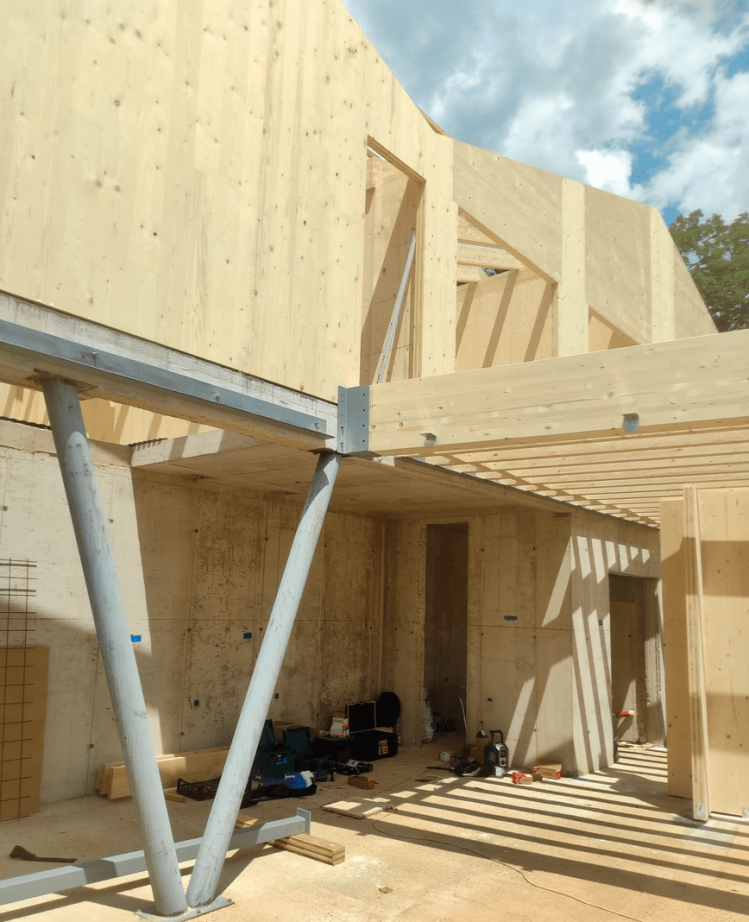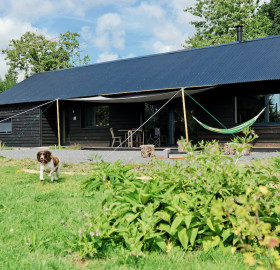Like chefs, architects have a difficult choice to make when starting a new project — what ingredients should the building be made of? Today’s landscape of conventional construction is teeming with hundreds of types and combinations of industrially produced materials. Each has different properties, making them more or less suitable for specific use cases.
However, there is an important aspect of construction that has, until recently, been largely neglected — carbon footprint. The situation is starting to change, which is a heartening development. Countries such as Denmark, France and the Netherlands are already introducing legislation and quotas to address the problem.
Yet a question remains. If we are to phase out regular carbon-intensive materials, what should architects replace them with? Thankfully, there is a plurality of low-carbon natural alternatives available, with high quality and performance to boot. And, of course, plurality invites comparison.
Let us conduct a brief analysis of a few select materials used for wall construction that merit consideration.
Cross-laminated timber (CLT)
Advantages:
- Strong and durable.
- Aesthetically pleasing.
- Fair fire resistance.
- Fast and dry construction.
- Renewable.
Disadvantages:
- Needs extra insulation when used for exterior walls.
- Overuse of wood.
- Complex services installation.
- Use of carbon intensive glue.
CLT is a stroke of Austrian engineering ingenuity. It is a panel system where each panel consists of multiple timber boards glued together in a perpendicular pattern. The result is a structural product that doesn’t bend and is strong as an oak (or, more commonly, spruce).
The panels are large, custom-made and prefabricated off-site. Assembly on-site is then a fast process of slotting pieces together. Additionally, the panels can be manufactured with pre-finished interior wood surfaces, although this does complicate things and requires careful planning and installation.
Viewed as a sustainable and easily renewable alternative, CLT and other engineered wood products are quickly becoming a popular recourse for construction and developer companies. Unfortunately, the renewability aspect of wood isn’t as ‘clear-cut’ and simple as re-planting trees. Wood harvest must be done in accordance with strict sustainable forestry practices, which is rarely the case.
Ultimately, the Achilles heel of CLT is the unnecessarily large amount of timber it uses. Timber is an excellent yet precious resource, best used sparingly with its full structural potential in combination with other natural materials, if possible. CLT also needs to be insulated, so the environmental impact of wall construction depends considerably on the insulation material and the wall build up as a whole.
Hempcrete
Photo: Eestimaaehitus
Advantages:
- Natural.
- Robust and homogenous.
- Renewable.
- Good thermal performance, if sufficiently thick.
- Resistant to moisture, fire, insects and rodents.
- Can be directly plastered over.
Disadvantages:
- Wet and labour-intensive process, if cast on site.
- Comparatively longer construction time.
- Cannot be worked with at cold or very warm temperatures.
- Working with lime requires strict safety precautions.
While lacking in load-bearing capacity, hempcrete holds its own as a good insulation material. It is made of hemp hurds (contents of hemp stalks) mixed with lime, which binds and preserves the plant material. The mixture is either wet-cast into a supporting frame or prefabricated into dry blocks or even whole walls.
Hempcrete is natural, renewable, non-toxic and widely considered to be sustainable. Lime has the ability to reabsorb carbon dioxide through carbonation, while hemp absorbs it via photosynthesis during growth. Sadly, the carbon-storing effect is mitigated to a degree by the energy required for lime production.
Hempcrete has proven to be resistant to fire as well as mould, insects and rodents. Many other bio-based materials also share this characteristic, despite being often underestimated in this regard. But, uniquely, hempcrete is also resistant to moisture — a much less common advantage among its peers. That said, protection against weather conditions and moisture is important regardless of how resistant a material might be.
On the flip side, the traditional construction method is a wet and labour-intensive process. The casting method requires a pan mixer on site for mixing hempcrete on the spot, and strict safety precautions, as lime can be aggressive to skin and eyes. Wet-cast hempcrete or lime mortar (in case of hempcrete masonry) need time to harden. That is assuming the temperature on a building site doesn’t drop below 5 °C, in which case it cannot be worked with.
Earth
Advantages:
- Unique aesthetic.
- Thermal mass and hygroscopic properties.
- Locally sourced and widely available.
- Highly sustainable.
Disadvantages:
- Needs insulation when used for exterior wall.
- Weather sensitive when building.
- Labour and time intensive.
Rammed earth, adobe, cob and wattle are ancient construction techniques that use raw materials, such as earth, in many different ways to create mostly robust monolithic or masonry walls or floors. One of its main advantages is low embodied carbon, making it highly sustainable. Production takes significantly less energy compared to concrete or burned bricks, and construction produces only minimal waste.
Another aspect where earth material shines is its ability to absorb and release heat (or remain cool) due to thermal mass and air moisture due to clay minerals. Therefore, earth can contribute to a healthier and stable indoor climate, if used in the interior.

On the other side of the coin, even thick rammed earth walls have rather poor thermal insulation, earning a spot on the disadvantages list. As a result, it needs additional insulation in cold climates, which can influence environmental impact. Earth is better suited for internal walls and surfaces, or for houses in warm climates where it excels.
Earth constructions are resistant to fire and pests, but they are susceptible to moisture-related issues. Adequate protection from exposure to rain is essential to prevent deterioration. That is especially true during construction, which is also a labour-intensive process with technical brakes for drying. Still, its distinctive appearance, abundance, low embodied carbon, thermal mass and air moisture micro-regulation make earth material an attractive prospect, albeit with careful consideration of specific project requirements.
Straw
Advantages:
- Great insulation.
- Carbon-storage.
- Renewable and widely available.
- Can be directly plastered over.
- Good fire resistance when covered with finishes
- Fast construction if prefabricated in panels or modules
Disadvantages:
- Can be labour intensive depending on building technique
- Vulnerable to moisture
- Weather sensitive when building
- Quality of bales may differ, unless they are certified products
Straw has something in common with each of the comparees. Like hemp, the main component is dried plant stalks and is mostly used as infill. When pressed together into bales or panels, straw becomes very sturdy and insulating, surpassing even hempcrete. This is because straw has a unique cell structure full of tiny air pockets, and doesn’t require lime as a binding agent.
Like CLT, both production and construction of prefab straw panels are dry and waste free processes. Sadly, the pleasant aesthetic of straw is, of course, lost once finishes are applied. However, CLT doesn’t compare favourably to straw in terms of renewability. It takes less than one year to grow wheat or hemp, but trees take decades.
Compared to earth, straw may be more sustainable thanks to its impressive CO2-storing ability and insulating properties. Neither earth nor straw need any kind of chemical treatment, thus the positive climate impact of both is uninhibited. Even without additives, straw is still fire resistant. Applying clay plaster on the walls seals the deal, putting any house fire fears to rest. That said, an unfortunate trait straw shares with earth material is its vulnerability to moisture. Both are vulnerable during construction and need to be protected from rain.
Another disadvantage is wall thickness. To achieve the best thermal properties, straw walls tend to be on the thicker side – 400 mm or more – making them more suited for exterior wall applications. The construction process can also be labour intensive, if one is working with straw bales. Thankfully, much like CLT and hempcrete, straw can come in the form of prefabricated panels with timber frames. Such a panel system simplifies construction, confers additional load-bearing capacity and ensures certified quality.
So, which material is the best?
As is often the case, we are forced to wrap up our search for the best option with a somewhat boringly predictable conclusion — it depends. Each solution has its strong points as well as weaknesses, and is better suited in some scenarios than others. The word “solution” is, in fact, something of a misnomer. There are no solutions, only trade-offs, and each of these materials has its place. A building can have straw exterior walls filled into a load-bearing wooden frame with interior clay plaster, earth or wooden floors, hempcrete or earth interior walls. And, of course, each of these alternatives are likely far better than the carbon-intensive conventional options still dominating the industry.










